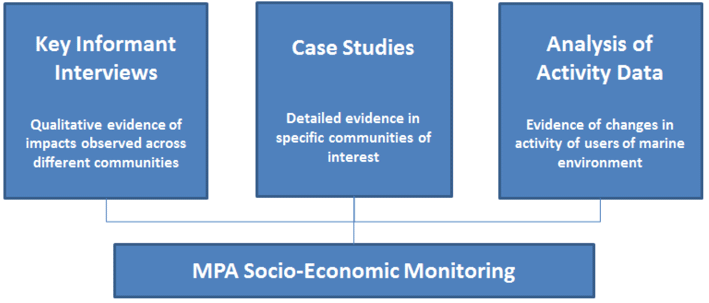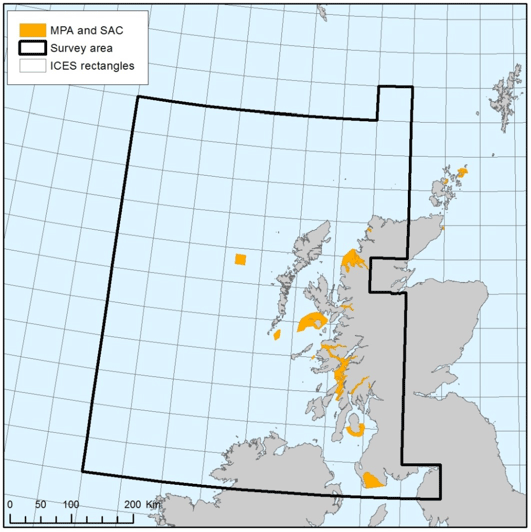Scottish Marine Protected Areas socioeconomic monitoring
This report provides an assessment of emerging evidence on the socio-economic impacts of Scotland’s Marine Protected Areas (MPAs).
2. Approach to monitoring socioeconomic impacts of MPAs
This section outlines the approach taken by Marine Scotland to gather evidence on the socioeconomic impacts of MPA management measures since their introduction in February 2016. These are summarised in Figure 2.
Figure 2: Summary of approaches to gathering evidence of the socioeconomic impacts of MPA management measures

2.1 Key Informant Interviews
Marine Scotland used key informant interviews with industry representatives for the fishing sector, seafood processing sector, local authorities and wider community interests to get an overview of observed positive or negative socioeconomic changes following the introduction of MPA management measures. Key informants were selected from a list of individuals and organisations who had engaged with processes to designate MPA sites and to develop the MPA management measures. The interviews were semi-structured (see Annex 3 for list of interview questions) and conducted by telephone or face-to-face.
Twenty four key informants were invited for interview of which eighteen were interviewed (see Annex 2 for the list of key informants). Six of those interviewed represented the fishing industry; four represented environmental non-governmental organisations ( NGOs); two local authorities; three the seafood processing, aquaculture and shellfish growing sectors; two local community groups; and one port authority.
Based on information provided by the key informants, of the eighteen interviewed, eight had previously taken a public position in favour of MPA management measures, four a public position against MPA management measures and six had taken no position either in favour or against the MPA management measures.
2.2 Case Studies
The case studies gathered site specific evidence on the impacts of individual MPAs on businesses and communities linked to the South Arran MPA in the Firth of Clyde, Wester Ross MPA in the North West Highlands and East Mingulay SAC in the Inner Minch off the Island of Barra. Case studies comprised of interviews with local stakeholders and businesses on observed socioeconomic changes in their communities that they could link to the introduction of MPA management measures (see Annex 4). Marine Scotland also collected evidence to identify or map hotspots of immediate and potential changes in fishing activity and other socioeconomic changes linked to MPA management measures.
Data collection at each site took place over three to four days. Questionnaires were used to collect data (see Annex 5) and to map observed changes in specific areas. Evidence gathering at each site focused on themes that Marine Scotland identified as most prominent from the analysis of evidence from key informant interviews as follows:
- South Arran MPA: sought to gather evidence on changes in fishing effort and to explore emerging opportunities for tourism and community groups. Interviewees providing evidence on tourism were based on Arran, whilst interviewees providing evidence on fishing effort were based in Troon and Campbeltown.
- Wester Ross MPA: focused on assessing changes in fishing patterns and the extent of displacement of fishing effort. It also explored projects and activities that local community groups were undertaking linked to MPAs. Interviews took place in Ullapool and Gairloch.
- East Mingulay SAC: focused on assessing changes in fishing patterns and impacts on onshore fish processing to test suggestions that reduced landings, of mainly Nephrops, had impacted on the availability of supplies to local fish processing businesses. Interviews for this case study took place on the Isle of Barra.
2.3 Activity Data Analysis
2.3.1 Fisheries activity
Analysis of spatial changes in fishing activity used data from IFISH, the UK's warehouse for fisheries data. The analysis used 2015 as a baseline for assessing changes in the level and spatial distribution of fishing activity following the introduction of MPA management measures in February 2016. When comparing 2015 with 2016, only data from January to September for each year was used as 2016 was not a complete year at the time of analysis.
Data on Nephrops (Nephrops norvegicus), king scallops ( Pecten maximus) and queen scallops ( Aequipecten opercularis) landed into Scottish ports by UK vessels was apportioned equally to where the fishing activity was declared within ICES area VIa and rectangles 38E4, 38E5 and 38E6 in ICES area VIIa. These are the sea areas considered relevant for monitoring the impacts of current MPA management measures on fishing activity, hereinafter referred to as the 'study area' (see Figure 2). The analysis used effort days and the number of voyages as proxies of fishing effort. Analysis examined if there were any changes in fishing activity and landings by: month of landing; ICES rectangle and; gear type.
The reader should note that the 2016 data used in this analysis is not officially published and may be revised with further data validation and quality checks. In addition ICES rectangles are large areas which in some cases encompass one or more MPAs as well as fishing grounds. For this reason no figures from this data analysis are referenced in the report; only qualitative changes in fishing activity are reported. Marine Scotland proposes future analysis using complete and official statistics and conducted at a finer spatial resolution, which will provide a more comprehensive report of changes relative to baselines before MPA management measures were in place. For more detail on the methodology used for this analysis please see Annex 7.
The approach taken for this report does not explicitly identify when fishing activity shifts within an ICES rectangle. Thus results using fisheries data should be treated as indicative of displacement effects.
Figure 3: Map of 'study area'- ICES area VIa and rectangles 38E4, 38E5 and 38E6 in ICES area VIIa

2.3.2 Other marine activities
The analysis of baseline data on the activity of other marine users used business registration data from the national Business Register and Employment Survey ( BRES). BRES collects data on the number of people employed in registered businesses by sector. Due to data reporting protocols, this report presents percentage changes in the number of people employed in registered businesses in different sectors between 2012 and 2015. Four sectors were analysed:
- Marine fishing
- Marine aquaculture
- Processing
- Marine tourism
A range of other marine spatial data is housed in the Marine National Plan interactive ( NMPi) - Marine Scotland's online warehouse of data for marine-based activities. The spatial distribution of the following marine-based activities was explored to provide background evidence for the case studies and a baseline of the spatial distribution of different marine activities for future monitoring:
- Scuba diving and dive sites
- Canoeing and kayaking
- Sea angling activity
- Royal Yachting Association ( RYA) areas
- Heritage sites (coastal and marine)
- Climbing and wildlife watching
- Keep Scotland Beautiful ( KSB) beach awards - Blue Flag and Seaside Awards
- Scotland's ferry routes
Contact
There is a problem
Thanks for your feedback